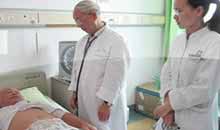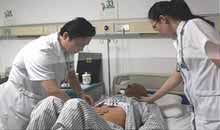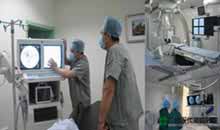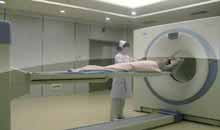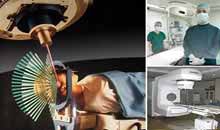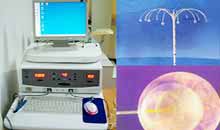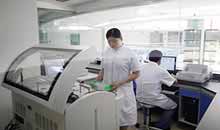- Basic
- Symptoms
- Diagnosis
- Treatments
What Is Lung Cancer?
Lung cancer is the most common primary malignant tumors of lung and the vast majority of lung cancers arise from bronchial epithelium, so lung cancer is also known as bronchial lung cancer.
Can Everyone Get Lung Cancer?
Research shows that 90% of lung cancers are closely related to smoking, so does it mean that the people who do not smoke have no risk of developing lung cancer? The answer is no. Experts from Modern Cancer Hospital Guangzhou point out that although it is still not completely clear about the real causes of lung cancer and its pathogenesis, it is clear that the risk factors that may cause lung cancer are not only smoking, the following three factors can also be the significant causes, so you must pay attention to them.
1. Air pollution
2. Pressure
3. Nutrition
In addition, factors such as viral infections, mycotoxin (Aspergillus flavus), tuberculosis, immune dysfunction, endocrine disorders and family genetics may play a role in the occurrence of lung cancer.

How Common Lung Cancer Is?
Lung cancer is more common among people over 40 years old and it is most common when people are at age of 60~79. The male and female ratio is 2.3:1.
What is the Best Treatment for Lung Cancer?
The treatment options for lung cancer include surgery, radiation therapy, chemotherapy, interventional therapy, cryotherapy, microwave ablation, biological immunotherapy, etc. For the early lung cancer that cancer cells have not spread or only partially spread, surgery can be done, when it is necessary, it can also be combined with radiotherapy and chemotherapy after surgery. For patients with advanced lung cancer, because they have lost the chance of surgery, minimally invasive therapy such as iodine particle implantation, interventional therapy and cryotherapy can be performed, those methods are with fewer traumas, quicker recovery, and can effectively improve the patient's quality of life, thus they have been widely applied in clinic.
Experts from Modern Cancer Hospital Guangzhou point out that, lung cancer treatment cannot unilaterally emphasize on local treatment or single type of treatment, it is advisable that multidisciplinary treatment methods, for instance surgery, radiotherapy, chemotherapy, traditional Chinese medicine, minimally invasive therapy should be combined to apply in accordance with different stages, different tissue types, and systematic condition of patients, thus the best efficacy can be achieved.
Before Seeing A Doctor, What Should You Do?
Cancer is not an untreatable disease and what so important is to actively face cancer, choose a good hospital and professional doctors. Here experts from Modern Cancer Hospital Guangzhou will teach you how to choose a hospital and give you several suggestions, hoping these will help you.
To Choose Professional and Normal Medical Institutions
Patients with lung cancer should choose professional cancer hospital that is rich in clinical experience of treatment, thus experts, facilities and rehabilitation service etc. are with high quality in these kinds of hospitals.
To Know the Basic Information of Lung Cancer Experts
Before visiting a hospital, you can firstly learn more about the cancer hospital through network, telephone or other channels, getting some basic information about the cancer expert you would like to talk with, in order to get an appointment and have a better communication with the expert.
Getting Preparations for Your Visit
It is advisable for patients to prepare those medical reports and records such as CT scan and blood test result and then take them to the expert you are going to visit, in addition, patients should tell the symptoms you are suffering, treatment you have received or is doing in detail to the expert, thus expert can give better diagnosis and then give you a more applicable treatment plan.
The Measures of Lung Cancer Rehabilitation
1. Patient can listen to light music, so as to relax and improve your quality of life.
2. Diet should be rich in nutrition, light and varied, for example, high nutrient foods that are easy to digest such as porridge, soup, combined with fruits and fresh vegetables.
3. Under the guidance of nurses and doctors, patients can do some exercise and keep a good state.
4. Family members and friends should give patients more encouragement and support, because stable emotion and positive and good mental state are conducive to a better rehabilitation.
What Knds of Supports Can be Obtained?
Practice proves that the clinic team services composed by multiple disciplines like oncosurgery, oncology, pathology, imageology and anesthesia doctors as well as professional nurses, can provide patients with most effective, most suitable and most economic treatment plan, and also can greatly improve the therapeutic effect of treating cancer patients.
“One station” medical system constructed by Modern Cancer Hospital Guangzhou combining multiple disciplines, can perform comprehensive diagnosis and treatment for patients under the condition of without adding patients’ burden. Therefore, on one hand, it can provide all-round and heartfelt medical services, and on the other hand, it improves medical efficiency and level. There are many channels can be applied to conduct the communication between patients and doctors, like online consultation, email, telephone conversation, and face-to-face consultation. All these consultation services can effectively help patients to fight the cancer. While the medical team faced by the patients includes doctors, nurses, dietitians, interpreters and so on to meet various demands in different level of different countries. Patients would be more confident under the unobstructed communication environment to cooperate the hospital to diagnose and treat the diseases.
The number of people with lung cancer is increasing every year, so to identify the symptoms of lung cancer is conducive to its treatment. Currently, lung cancer is one of the most common primary malignant tumors of lung, which mostly originates in bronchial epithelium, so lung cancer can also be called bronchial lung cancer.

Common Symptoms of lung cancer
1. Cough: there are about two thirds of patients have cough, which is the most common symptom of early lung cancer. It can be manifested as mild dry cough, severe cough, cough with high frequency or cough at night.
2. Hemoptysis (Coughing up blood): it is also a symptom of early lung cancer and it is more obvious in male smokers. It is manifested as coughing up phlegm with blood or intermittent bloody sputum, and having repeated infections somewhere in the region of lungs.
3. Chest pain: it is a symptom in about 30 percent of people with lung cancer. If the tumor is close to lung membrane, the pain can be dull or vague and cough intensifies when breathing or coughing. If cancer has invaded lung membrane, persistent pain can be caused.
4. Fever: fever due to lung cancer is a kind of cancerous heat which is mostly caused by inflammation that tumor blocks bronchus of lung, causing inadequate drainage. The fever is generally below 38 degree, ineffective to antibiotic treatment, and tends to develop repeatedly.
5. Chest distress and shortness of breath: they are most common symptoms of early lung cancer. They usually result from a blockage to the flow of air in part of the lung, collection of fluid around the lung (pleural effusion), or the spread of tumor throughout the lungs.
6. Clubbed finger: known as drum hammer finger, it is manifested as enlargement of the first joint of fingers and toes, protruded and curved of nails, and pain. If you find yourself having those signs, you need to pay attention to prevent lung cancer.
7. Arthritis: it is manifested as wandering and burning pain of the joint of elbow, knee, ankle, wrist, and finger, inability to use the hand or walk.
Experts from Modern Cancer Hospital Guangzhou remind: once these suspected symptoms of lung cancer are found, you should go to regular hospital for further check and treatment. If you are unfortunately diagnosed with lung cancer, we would like to provide online consultation and give individualized suggestion for you. Contact number: 63-2-8221222.
Diagnosis of lung cancer is a key to detect it early. As symptoms of early lung cancer are easily confused with many diseases, which is also an important factor resulting in patients’ delay of treatment. When diagnosed, most of patients with lung cancer have been in middle and even advanced stage, which is not conducive to the treatment. That’s why the diagnosis of lung cancer is so important.

Chest X-ray
Chest X-ray: this is commonly first lung cancer imaging test you will experience. Central lung cancer in the early stage can show no abnormal signs in X-ray. When the cancer obstructs bronchus, causing obstructive pneumonia or atelectasis, or the tumor invades adjacent lung tissues and metastasizes to pulmonary hilus, mediastinal lymph nodes, mass in the region of pulmonary hilar or widened shadow in mediastinum can be seen. X-CT can show shadow of mass growing into bronchial cavity and the wall of its tube is irregular, thickening or the cavity is narrowing, blocked. X-ray of peripheral lung cancer often is manifested as nodular shadow around lung lobe or mass shadow, often showing small sublobe or notch with fine and short sentus. Diffuse bronchioalveolar cell carcinoma is manifested as infiltrating lesions, vague edge, a wide range of small nodules merging into a large shadow, which is similar to pneumonia.
CT Scanning
CT scanning: a CT scan of the chest may be ordered when X-rays do not show an abnormality or do not yield sufficient information about the extent or location of a tumor. CT scans are X-ray procedures that combine multiple images with the aid of a computer to generate cross-sectional views of the body. The images are taken by a large donut-shaped X-ray machine at different angles around the body. One advantage of CT scans is that they are more sensitive than standard chest X-rays in the detection of lung nodules, that is, they will demonstrate more nodules. Moreover, it avoids overlap of lesions with normal tissue, can find early lung cancer in hidden area that general x-ray cannot show (such as at tip of lung, above the diaphragm, around the vertebral column, behind the heart, mediastinum etc.); CT enhancement scanning is valuable to determine whether there are porta pulmonis (hilus of lung) metastasis and mediastinal lymph nodes metastasis; the more; CT scans of the abdomen may identify metastatic cancer in the liver or adrenal glands, and CT scans of the head may be ordered to reveal the presence and extent of metastatic cancer in the brain.
Magnetic Resonance Imaging
Magnetic resonance imaging (MRI): it can easily distinct the vessels, masses and lymph nodes in mediastinum and hilum of the lung. Besides, with multi-faceted imaging, it can better show the extent of tumors and involvement of blood vessels. However, CT scanning is highly recommended for pulmonary solid lesions.
Pet Scans
PET scans: differentiated from traditional imaging techniques, PET scans measure metabolic activity and the function of tissues. It can determine whether a tumor tissue is actively growing and can aid in determining the type of cells within a particular tumor. However, as for lung tumors, MRI may give false positive results on the tumors with low metabolism, particularly the alveolar cell carcinoma, and also on lung inflammation, tuberculosis, etc.
Pathology Examination
Pathology examination: diagnosis of lung cancer mainly depends on the examinations of tissue, cytology, and clinically many auxiliary examinations are used for collecting specimens of lung cancer. Cytological specimens mainly come from sputum, serous cavity effusion, brush biopsy by fiberoptic bronchoscopy and various regions of specimens by fine needle aspiration.
If you have been diagnosed with lung cancer, we are here to provide online consultation and give individualized suggestion for you. Contact number:63-2-8221222.
Lung cancer which is one of the malignant cancers causes most severe harm in the world, so can lung cancer be treated? Experts said that although cancer is an international hard nut, clinically there are many treatment options for lung cancer. For patients with middle and advanced lung cancer, their prognosis mainly depends on whether treatment methods are proper and patient's physical condition. The treatment for middle and advanced lung cancer mainly include chemotherapy, radiotherapy and traditional Chinese medicine, so how to choose the treatment most applicable to the patients?

Combination of TCM & Western Medicine
Treatment for lung cancer are mainly surgery, other treatment options such as radiotherapy, chemotherapy, immunotherapy, combination of TCM and western medicine, cryotherapy, interventional therapy, etc.
Surgery
Surgery is applied to remove tumors, including radical resection and palliative resection. But only patients with early and middle lung cancer are applicable to radical resection, which only accounts for less than 40% of the total patients with lung cancer.
Currently, surgery is still one of the major options for lung cancer treatment. The indications and types of surgery are determined by location, involved region of tumor and patient's general condition especially cardiopulmonary function reserve. The principle of surgery is to completely remove lesions and maximally preserve healthy lung tissues.
Radiotherpy
Radiotherapy includes irradiation in cavity and irradiation in vitro. The devices include radium, X-ray machine, cobalt bomb, accelerator which are mostly used and post-installed machine, "photon knife" which are developed in recent years.
Radiotherapy can be also used as adjunctive therapy before and after surgery so as to increase resection rate and long-term survival rate after surgery, besides, radiotherapy is also applicable to squamous cell carcinoma that cannot be treated by surgery or that are recurrent and metastatic.
Radiotherapy can be divided into simple radiotherapy and comprehensive radiotherapy. Simple radiotherapy consists of radical radiotherapy and palliative radiotherapy. To choose which kind of radiotherapy should be in accordance with pathological types, extent, and metastatic situation of lung cancer, lung function and systemic conditions. Comprehensive radiotherapy combines radiotherapy with surgery and chemotherapy, which has higher survival rate than any other single treatment.
Interventional therapy is a mini-invasive therapy performed under the guidance of medical imaging equipments. With a 1-2 millimeter incision, paracentesis could be performed with the lead of medical imaging equipment. Then a special tube, catheter or other sophisticated apparatus are introduced into human body to treat the lesion, so as to cut off the cancer’s blood supply. Interventional therapy is widely applied in the diagnosis and treatment of lung cancer with advantages of small trauma, good efficacy and few side effects.

Microwave Ablation
The performance of cryotherapy requires doctors to not only have high medical technology, but also should be familiar with radiography and anatomy. Cryotherapy makes an accurate calculation of the direction, angle, quantity and potency dimension for the puncture of Ar-He knife to the tumor. When the medicine reaches the tumor, it will not bring harm to the normal tissue. Lung cancer patients can get a good efficacy when combining cryotherapy with other technologies.
Biological immunotherapy is a therapy that injects immune cells which have anticancer activity into lung cancer patient’s body to kill cancer cells and activate the anticancer immune response. The biological immunotherapy first isolates DC, CIK mononuclear cells from patient’s peripheral blood, and then activates and cultures the DC-CIK cells in the laboratory. The DC-CIK cells finally will be transfused back to the patient’s body to kill cancer cells, prevent recurrence and metastasis. Biological immunotherapy overcomes the disadvantages of operation, radiotherapy and chemotherapy, such as no thoroughness, easy metastasis and great side effects.
Under Microwave Ablation, when tumor tissue is killed by heat, it can also produce heat shock proteins, which have effect on stimulating the patient’s immune system, improving immune function and playing a role in inhibition of tumor cell proliferation.
If you have been diagnosed with lung cancer and want to know the treatment option according to your individualized condition, please click online consultation.
If you have any questions, please contact us via online consultation, email or phone call. If you find our website useful, please follow our FaceBook and YouTube, health information will be updated regularly.






